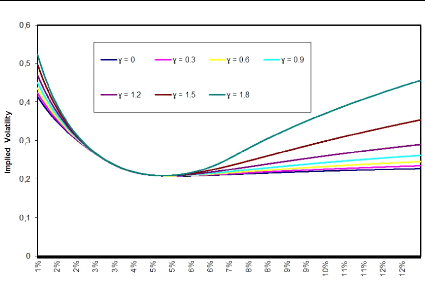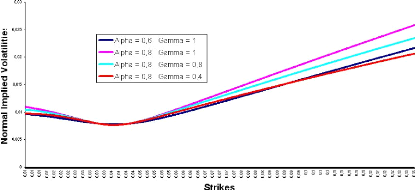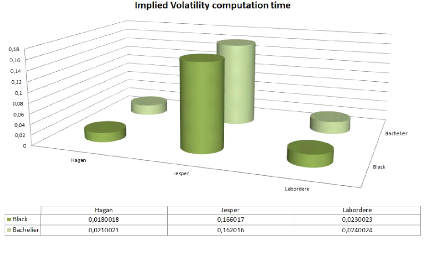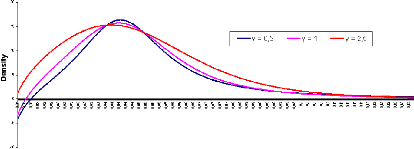Conclusion
The Normal SABR model solves the negative density problem
observed with the Hagan approximation. However, it introduces another issue,
the excessive computation time for pricing. Indeed, practitioners prefer closed
form formulas for pricing (such as Black-Scholes) and changing the whole
pricing kernel can quickly become a trip to Pandemonium. Moreover, solving only
the negative density problem leaves untouched the wings control one. In the
next chapter, we will introduce a wings controlling model and show how to
compute arbitrage-free prices.
CHAPTER 2. NORMAL SABR
20 4. PRICING FORMULA WITH NORMAL SABR AS BASE
Chapter 3
The ZABR model
Introduction
Interest rate option desks typically need to maintain very
large amounts of inter-linked volatility data. For each currency, there might
be 20 expiries and 20 tenors, that is, 400 volatility smiles. Furthermore, the
smiles might be linked across different currencies. Interpolation of observed
discrete quotes to a continuous curve is needed for the pricing of general caps
and swaptions. At the same time, extrapolation of options quotes is needed for
constant maturity swap (CMS) pricing. For these purposes, the industry uses to
approximate SABR model using expansions as in [26]. The implied volatility
expansions have the advantages that they are fast and simple to code but as
mentioned in the previous chapter, these expansions are not very accurate,
particularly not for long maturities nor low strikes.
With the low rates we have today, this problem is more acute
than ever. Furthermore, the SABR model only has four parameters to handle the
above-mentioned tasks, which is not enough flexibility to exactly fit all
option quotes. In this chapter, we extend the stochastic volatility process to
include a constant elasticity of variance (CEV) skew on the volatility of
volatility. The CEV volatility process allows us to have more explicit control
of the extrapolated high-strike volatilities, which in turn allows better
control of CMS prices. Further, we will use a non-parametric volatility
function for the spot process, which enables us to have an exact fit to all the
observed quotes and gives us the ability to model negative option strikes.
In this chapter, instead of buying into heat kernel
expansions, we use a short-maturity expansion for the implied volatility of the
option. The short maturity expansion also yields results for the short-maturity
limit of the Dupire forward volatility ( [11]), that is, the short-maturity
limit of the conditional expected local variance
V(F)2 = uim
t?0
|
|
]
dhF it
dt /Ft = F (3.1)
|
|
21
We provide two procedures to directly calibrate the model to
observed CMS prices: an implicit method that works by iteration of the
connection from parameters to price in a non-linear solver (see Section 3.3),
and a direct method that infers the
22 1. SHORT MATURITY EXPANSION
CHAPTER 3. THE ZABR MODEL
parameters of the model from an arbitrage-free continuous
curve of option prices (see Section 5).
1 Short maturity expansion
We consider the slightly more general model:
( dFt =
ót?(Ft)dWt1
with d(W1,
W2)t = ñdt (3.2)
dót =
c(ót)dWt2
The non-parametric form of the volatility function ?(.)
allows us to have a perfect fit to any discrete or continuous set of observed
arbitrage-free options quotes. We can write the price of an European call
option on a fixing FT as:
Ct = E [(FT -
K)+ /Ft] = g (t, Ft, v(t))
where v(t) is the implied normal volatility and g is the
normal (Bachelier) option pricing formula:
g(ô, x, v) = (x - K)JV x - K +
vôfv.Vô)z
Cv~K) , ô = T
- t (3.3)
Applying Itô's lemma to 3.3 yields:
dCt = -gôdt +
gxdFt +1
gxxd(F)t + gvdvt +
2gvvd(v)t +
gxvd(F, v)t (3.4)
where subscripts
denote partial derivatives. In the following, we assume vt > 0
Define Xt = Ft-K. Using Itô's
lemma yields:
vt
1
dXt =
vt
|
dFt -Ft 2Kdvt -
2d(F,v)t + Ft
-3Kd(v)t
vt vt
vt
|
|
(3.5)
(3.6)
1
= (dFt - Xtdvt) +
O(dt)
vt
d(X)t = v2
(d(F)t + Xt d(v)t -
2Xtd(F, v)t)
t
2
gxx
gxx
The normal option pricing function, g, has the following
properties:
gv = vôgxx
Cx - K
gvv = v
x - K
v
gxv =
1
0 = -gô +
2v2gxx
Using the above properties, we can transform equation 3.4
into:
1. SHORT MATURITY EXPANSION
23
CHAPTER 3. THE ZABR MODEL
1 ]
dCt - gxdFt = 2gxx [v2
t (d(X)t - dt) + 2ôvdvt (3.7)
The left
hand side of 3.7 is the change in value of a hedged portfolio. Taking
conditional expectations yields:
1
0 = 2gxxv2
1 t E (d(X)t - dt/Ft) +
gxxôvtE (dvt/Ft) (3.8)
For small
maturities, ô -+ 0, and we have
2gxxv2t E
(d(X)t - dt/Ft) 0 (3.9)
As gxx > 0 for v > 0, and for any diffusion, E
(d(X)t - dt/Ft) = 0 is equivalent to
d(X)t = dt, we obtain the arbitrage condition:
Note that this is a diffusion condition rather than the drift
condition that we normally see in financial mathematics. As the function X
H X(f, ó) must be a function of the state variables
(Ft, ót), the diffusion condition 3.10 leads to the
differential equation:
1 = (XfdFt +
Xódót)2
dt (3.11)
=
ó2t
?(Ft)2X2f
+
E(ót)2X2ó
+
2ñót?(Ft)c(ót)XfXó
Given the function ?(.), we need to solve this non-linear
first order differential equation subject to the boundary condition X(f = K,
ó) = 0. Once we have the solution X(f, ó), we can find the
implied volatility as:
F - K
=
v(3.12) X(F,ó0)
We note that the error of the implied volatility is
O(ô). The result implies that for any choice of ?(F), any function X =
X(f, ó) that satisfies d(X)t = dt leads to an implied
volatility given by v = (F - K)/X.
We could have chosen to derive the short-maturity expansion
in implied Black-Scholes (lognormal) volatility v instead of implied normal
volatility. Instead of X,
we should then have chosen the transformation
. The diffusion condi-
X = ln(F/K)
v
tion would be the same so X = X. This relates
short-maturity implied lognormal and normal volatilities, as in Appendix B
(first order equivalence), by the simple relationship:
v ln(F/K)
= (3.13)
v F - K
The expansion results that we present in the following can
easily be switched between use in implied normal and implied lognormal
volatility form by use of equivalence formulae.
CHAPTER 3. THE ZABR MODEL
2 Application to benchmark models
Before we address the very ZABR model results, we first of all
apply the short-maturity expansions from the previous section to well known
models. Those models can be retrieved while varying the function c(.).
2.1 Local Volatility model : case ~(ót)
= 0
In this case, ót = 1, and the differential equation 3.11
reduces to ordinary differential equation (ODE):
X2f?(F)2 = 1 (3.14)
Using the boundary condition X(F = K) = 0, we find the
solution:
Z F 1
X = ?(u)
K
|
du (3.15)
|
|
v = v =
with corresponding implied normal and Black volatilities given
by:
F - K
f F K ?(u)du
1
(3.16)
ln(F/K)
f F K ?(u)du
1
These results appear in many places, for example in [19]. We
note that 3.15 implies the following relationship between X and the forward
volatility:
Suppose we have X from a stochastic volatility model like
3.2, that is, given as the solution to 3.11 for some volatility functions ?(F),
c(ó) and correlation ñ. Let's define the function V by:
~?X ~-1
V(K) = - (3.18)
?K
and consider the deterministic local volatility model:
dFt = V(Ft)dWt (3.19)
It now follows that:
XLV =
|
Z S K
|
V(u)-1du = X (3.20)
|
|
24 2. APPLICATION TO BENCHMARK MODELS
So the stochastic volatility model 3.2 and the local
volatility model 3.19 will produce the same short-maturity expansion option
prices.
The above is a short-maturity limit version of the general
result by Gyongy and Dupire (see [13] and [6]), that the model:
CHAPTER 3. THE ZABR MODEL
dFt = a(t, Ft)dWt , F0 = F0 (3.21)
produces the same option prices as the model 3.2 if a(., .) is
chosen to be:
~dhF it ~
a(t, k)2 = E dt /Ft = k (3.22)
We conclude that in the short-maturity limit, the conditional
expected variance of the underlying is related to the transformed variable X
by:
-2
V(F)2 t~o E
[dhdtit/Ft =
F~ = (?K\ (3.23)
This constitutes a way of relating the two dimensional
pricing problem 3.2 to the simpler one-dimensional pricing problem 3.19. We
will make use of this relationship to generate arbitrage-free prices later.
2.2 Degeneracy into a SABR model : case €(ó) =
áó
Here, we will solve the diffusion condition for the lognormal
volatility process case. First, we use the transformation:
Y :=
LF
?(u)
1
du (3.24)
and we get:
dY = dWt1 -
áYdWt2 + O(dt)
= [1 + á2Y 2 -
2ñáY ]1/2 dBt + O(dt) (3.25)
= J(Y )dBt +
O(dt)
where (Bt)t is a new Brownian motion. As Y (F = K)
= 0, we can now get X by normalising the volatility of Y , hence:
fY X=J J(u)-1du
= 1ln(J(Y ) - ñ + áY\
o 1--p
v =
|
F - K
|
|
(3.26)
|
|
|
|
ln(F/K) X
|
|
|
For the CEV case ?(F) = ?0Fâ, we have:
1
Y = ó0?0
F1-â - K1-â
(3.27)
1 -â
These formulas are basically the result of Hagan et al
[26]. This is extended to include maturity and various refinements for the
CEV case. The Hagan result does,
2. APPLICATION TO BENCHMARK MODELS 25
CHAPTER. 3. THE ZABR. MODEL
however, produce implied volatility smiles that are prima
facie identical to those produced with formula 3.26.
We can also use 3.26 to retrieve the forward volatility
function of SABR from:
?X ?K =
|
?X
?Y
|
?Y ?K =
|
J(Y ) Ç0?(K))
(3.28)
|
|
26 3. EXPANSION FOR. THE ZABR. MODEL
Hence:
V(K) = J(Y
)ó0?(K) (3.29)
This result could also be deduced from results in [25].
3 Expansion for the ZABR model
We now consider the extended SABR model where the volatility
process is of the CEV type: c(ó) =
áó,y
3.1 Implied volatility computation
Once again, we introduce the intermediate variable:
F
Y = ó,y-2 1
x ?(u)
|
du (3.30)
|
|
For which Itô expansion yields:
dY = ó,y-1 (dW t 1 +
(ã - 2)áYdW 2 +
O(dt) (3.31)
0 t
Let's define X = ó1-,y
0 f(Y ), for some function
f(.), and we get:
dX =ó1-,y
0 f'(Y)dY + (1 -
ã)áf(Y)dWt2
+ O(dt)
[ ] t + O(dt) (3.32)
= f'(Y)dW t 1 +
(ã - 2)áY f'(Y) +
(1 - ã)áf(Y) dW 2
We conclude that the diffusion condition 3.9 is satisfied if f
solves the ODE:
1 = A(Y )f'(Y
)2 + B(Y )f(Y
)f'(Y ) + Cf(Y
)2
A(Y ) = 1 + (ã -
2)2á2Y 2 + 2ñ(ã -
2)áY
B(Y ) = 2ñ(1 -
ã)á + 2(1 - ã)(ã -
2)á2Y
C = (1 -
ã)2á2
f(0) = 0
The above ODE can be rearranged as:
|
(3.33)
|
|
f'(Y ) =
Y -B(Y )f + B(Y
)2
f2 - 4A(Y )(Cf2 - 1))
F(Y, f) (3.34)
2
CHAPTER 3. THE ZABR MODEL
which can be solved by standard techniques for integration of
ODEs. We can evaluate the solution for all strikes one sweep by:
= -ó0
?(K)-1
ã-2
?Y ?K
?K =
ó1-ã
0
=
-ó-1
0 F (Y,
óã-1
0 X)
?(K)-1
(3.35)
?X
?f ?K
X(K =
F) = Y (K
= F) = 0
Again, we can find the forward volatility function as:
/?X\-1=
ó0?(K)f'(Y
)-1 =
ó0?(K)F
(Y, óã-1
0 X)-1 (3.36)
V(K) = -
?K
Equations 3.35 and 3.36 will typically be evaluated at
ó0 = 1. Rather than numerically solving the
two ODEs in 3.35 separately, we favour solving 3.33 as a joint system.
It should here be noted that the ODE representation 3.33 has
previously been obtained by Balland (see [24]) for the lognormal case. Further,
it should be noted that Henry-Labordere has a treatment of the general non-CEV
case (see [27]).
3.2 Graphical results
In order to solve the ODE 3.33, we have the choice between a
classical Euler scheme and an 4th order
Runge Kutta relaxation. The former is faster but deliver unstable solutions,
whereas the latter, even though slower, yields excellent solutions in terms of
stability. We therefore chose a RK4 method to solve the ODE. After solving it,
we find a value for X which leads to the implied volatility. The following
picture plots obtained lognormal implied volatilities for different values of
ã.
3. EXPANSION FOR THE ZABR MODEL 27
28 3. EXPANSION FOR THE ZABR MODEL
CHAPTER 3. THE ZABR MODEL

Figure 3.1: F0 = 0.0325, u0 = 0.087, á
= 0.47, 9 = 0.7, p = -0.48, T = 15Y
Increasing 'y lifts the wings of the implied volatility smile
whereas the smile for strikes close to at-the-money are visibly unaffected.
This can in turn be used to give us better control over the CMS prices.
Here is an illustration of how to control CMS prices through
the wings. When we increase á, we lift the wings and therefore raise the
CMS prices. We can then decrease 'y and therefore lower back the wings and the
CMS prices, as we can see it through the following illustration.

Figure 3.2: F0 = 0.0325, u0 = 0.087, 9 =
0.7, p = -0.48, T = 15Y
In terms of computation time, we have plotted the time it takes
to compute an implied volatility in a ZABR('y = 1) and compared it with the
time taken by Hagan
CHAPTER. 3. THE ZABR. MODEL
and Labordere approximations.

Figure 3.3: F0 = 0.0325, ó0 = 0.087, á = 0.47,
â = 0.7, ñ = -0.48, ã = 1, T = 15Y
It takes 10 times more time for computing implied volatility
under the ZABR model, in comparison with Hagan and Labordere approximations.
However, this is just the price to pay for gaining control of the wings !
3.3 Fast calibration of the model's parameters
For quick identification of the model parameters, the
following second-order Taylor expansion is convenient:
v(K) = v(F) + v,(F)(K - F) +
12v,,(F)(K - F)2 + O ((K -
F)3) v(F) = ó0?(F)
1 v,(F) =2
hó0-1 ñá + ó0? (F)i
v,,(F) 6ó0?(F)hó02(7-1) ((-5 +
2ã)ñ2 + 2) + óô
(2?(F)?,,(F) - ?,(F)2)i
(3.37)
Let's consider a CEV case where we set ?(K) = ù (K-F
)â
have:
(F -F )â and ó0 = 1. Then we
v(F) = ù
v,(F) = 21 [~
ñá + Fùâ - F
~~(-5 + 2ã)ñ2 + 2 á2 +
ù2â(â - 2) ~
v,,(F) = 1
6ù (F - F)2
3. EXPANSION FOR. THE ZABR. MODEL
|
(3.38)
29
|
|
CHAPTER 3. THE ZABR MODEL
|
\ v(K1), ...,
|
|
For a given set of discrete quotes
|
|
|
be used for regressing the triple v(F), v'(F),
v"(F). One can in turn solve 3.38 to get parameters estimates for â,
ñ, á.
4 Finite difference volatility
Using the implied volatility coming from the short-maturity
expansions 3.16, 3.26 and 3.35, directly for pricing using 3.3 will not give
arbitrage-free options prices. Our short-maturity expansions suffer from the
same problem of potential negative implied densities for low strikes as the
original Hagan expansion. The ZABR model contains an enhanced feature that can
help us avoid negative density problems. Let's plot the implied probability
density function for extreme model parameters and see how it reacts to the
changes in ã values.

Figure 3.4: F0 = 0.0325, ó0 = 0.087,
á = 0.47, â = 0.7, ñ = -0.48, T = 15Y
If we keep increasing ã, the density tends to be more and
more positive... Anyway, this way of skipping negative densities doesn't give
us enough flexibility in the use of the ZABR model.
In order to definitely avoid this problem, we will instead
use the forward volatilities derived in 3.29 and 3.36 as the basis for our
pricing.
The forward volatility V(K) can be used to generate
option prices as the solution of the Dupire forward PDE (see [5]).
?C(T,K)
?T =
?
?
?
2V(K)2 ?2
?(T2,K)
C(0, K) = (F - K)+
(3.39)
30 4. FINITE DIFFERENCE VOLATILITY
The usual way of solving this numerically is to set up a time
discretisation with multiple time steps and then use a finite difference
solver. However, to gain speed, we will instead use the single time step
implicit finite difference approach introduced in [15]. Here we need to solve
the ODE:
C(T, K) - 2T
è(K)2?2C(T, K)
1 ?K2 = (F - K)+ (3.40)
4. FINITE DIFFERENCE VOLATILITY 31
CHAPTER 3. THE ZABR MODEL
Z0
It is shown in [15] that this approach generates a set of
arbitrage-free call prices for any choice of è. It is also shown that
the one-step finite difference price is the Laplace transform of the solution
to 3.39. The Laplace transform of the Gaussian distribution is the Laplace
distribution:
8 t/T 1 F - Kl T
IF K|
vt
vt
dt = e 2v2 (3.41)
v
v
2v2
which is peaked at K = F. Therefore if we choose è =
V, we will also get a peak in the densities.
Instead, we will find an adjustment for the forward
volatility function based on our expansion results. As option prices generated
by 3.39 and 3.40 should be the
same, we can substitute ?2C(T,K) ?C(T,K)
?K2 = 2 ?T from 3.39 into 3.40 and rearrange to
V2
find:
è(K)2 = V(K)2 C(T, K) - (F -
K)+
T ?C(T,K)
?T
V(K)2g(T, F,v) - (Fv)
- K)+
T ?g(T
?T
|
(3.42)
|
|
~ ~
1 - î Ö(-î)
= 2V(K)2 , with î= v X
ö(î) T
= V(K)2P(X)2
where the second (approximated) equality involves the
approximation of the option prices by our expansion result.
The function P(X)2 can conveniently be
approximated with a third or fifth order polynomial. Specially:
Ö(X) X
ö(X) anun, u = 1 (3.43) 1 + pX
n
where the constants p, a1, a2, ... can be found in (26.2.16)
and (26.2.17) of [20]. The finite difference discretisation of 3.40 is:
~ ~
1- 1 2Tè(K)2 ?2 C(T, K) = (F - K)+
(3.44)
?K2
This equation can be represented as a tridiagonal matrix
equation on the grid K0, K1, ..., Kn, which in turn can be solved
for C(T, Ki) in linear CPU time using the tridiag() algorithm in [31].
As an alternative to the finite difference solution 3.44, one
could use the exact solution methodology for ODEs of the type 3.40 described in
[3]. However, for this methodology to be computationally effective, the forward
volatility function è(K) needs to be well approximated by a piecewise
linear function with few knot points over the full domain of the solution. This
is generally not the case here. We have therefore chosen to base our solution
on 3.44.
We can see that the finite difference generated option prices
have corresponding implied densities that are positive, that is, arbitrage is
precluded. We can also
CHAPTER 3. THE ZABR MODEL
see that using our forward volatility result,
V(K), directly in the
single time step finite difference solver produces a density that is peaked
around at-the-money. This, however, is eliminated when using the adjusted
forward volatility
è(K).
5 Calibrating the Volatility function
We first consider the case where we have a continuous curve
of arbitrage-free option prices. This could for example be produced by
Andreasen & Huge interpolation scheme ( [15]) or come from another ZABR
model. We can calculate the forward volatility function by the discrete Dupire
equation:
è(K)2
= 2C(T,
K) - (F -
K)+ (3.45)
T ?2C(T,K)
?K2
Using 3.36, we can calibrate the volatility function:
F (Y, óã-1
0 X)
è(K)
?(K) =
(3.46)
ó0P(X)
?Y
where X and Y are found from 3.35 as the solution to the ODE
system:
ó0 P
(X)
ã-1
?X P(X)
(3.47)
?K =
è(K)
X(K =
F) = Y (K
= F) = 0
The above ODE system can be solved for all strikes in one
sweep. However, typically, we prefer to calibrate directly to the observed
discrete quotes. This is done by solving the ODEs in 3.35 and 3.36 and
including the one-step finite difference adjustment 3.42:
?X ?K =
F (Y, óã-1
0 X)
(3.48)
ó0?(K)
P(X)ó0?(K)
è(K) =
F (Y,
óã-1
0 X)
X(K =
F) = Y (K
= F) = 0
32
5. CALIBRATING THE VOLATILITY FUNCTION
After solving numerically the above system, we can find the
option prices using the one-step finite difference algorithm in 3.44. On top of
this, we can use a nonlinear solver to calibrate the volatility function
ó(K) to observed
discrete option quotes. As we get all option prices in one sweep, we can
include CMS forwards and option quotes in the calibration without additional
computational costs.
CHAPTER 3. THE ZABR MODEL
Even though non-linear iteration is involved, this procedure
is very fast. Typically, we can calibrate a non-parametric volatility function
with 10 knot points to a given smile in roughly 50 iterations, which takes
approximately one millisecond of CPU time.
When it comes to outright pricing speed, the ZABR model is
capable of generating 100'000 smiles, each consisting of 256 strikes in
approximately seven seconds. It should be stressed that this includes both
numerical ODE and finite difference solutions. This is actually faster than
direct use of Hagan's SABR expansion, which takes 10 seconds for the same task.
The reason for this difference is mainly that one time-step finite difference
is faster at producing prices than the Black formula. An alternative to the
ZABR model for producing arbitrage-free options prices is the Fourier-based
models, found in [2] for example. For a displaced Heston model (see [1]),
numerical solution for 100'000 smiles consisting of 256 strikes via the fast
Fourier transform with the Black-Scholes formula used as a control variate
takes around 18 seconds (see [14]). It should be noted that this type of model
is considerably less flexible with respect to fitting discrete quotes and more
difficult to implement.
Though we generally use 3.48 in conjunction with a non-linear
solver for the calibration, the direct calibration methodology 3.47 is relevant
as it admits direct calibration of one ZABR model to another.
The stochastic process (Xt)t
has unit diffusion and thus, in the sense of the short-maturity
limit, is normally distributed. So it is natural to use a uniform spacing in X
and a non-uniform spacing in K. For this, the ODE system 3.48 can conveniently
be transformed to:
?Y
|
óã-1
0
|
?K =
|
F (Y, óã-1
0 X)
|
?K
|
ó0?(K)
|
|
|
|
?X =
(3.49)
F (Y, óã-1
0 X)
P (X)ó0?(K)
è(K) = F (Y,
óã-1
0 X)
Y (X = 0) = 0, K(X = 0) = F
In our implementation, we solve 3.49 on a uniform X grid to
generate and fix a non-uniform strike grid k0, k1, ... , kn
that is used in the numerical solution of 3.48 during
calibration and pricing. As a final remark, we note that ODEs in this section
typically will be solved at ó0 = 1.
| 


